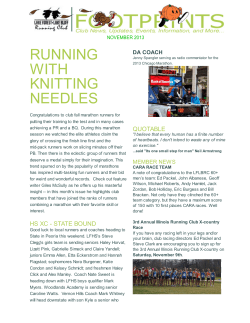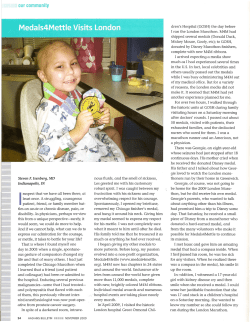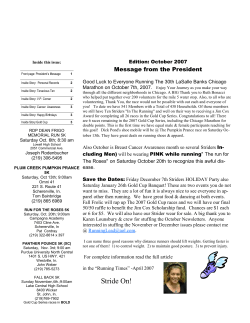
Document 153810
12-week Half Marathon Training Program By Ben Wisbey Introduction The half marathon is often the intermediate goal for those runners looking at doing their first marathon. It is also the longest distance running event that experienced runner's can compete without interrupting their regular racing and training program. For these reasons, and many more, the half marathon is a very popular event, and one that is often overlooked in regards to its importance in the lead up to a marathon. While the half marathon does require significant amounts of strength and endurance, the real beauty of this distance is that it also has a large speed component. This combination of strength, endurance and speed, makes for enjoyable training that can be of benefit to those with a longer term goal of a marathon or even a 10km. During this article, 2 programs will be outlined. One is for those runners with the main goal of breaking the 100 minute mark, and one for those runners aiming for a time over the 100 minute mark. How do you assess your goal time for a half marathon? If you wish to go under the 100 minute mark for your upcoming half marathon, then as a guide you will need to be capable of running about 22 minutes for 5km or 45 minutes for 10km. Although these are only a guide, if you are not close to these times, then your speed will be a limitation in achieving this half marathon goal. If you are able to do these or similar times over the shorter distances, then with appropriate strength and endurance work, you should be capable of breaking 100 minutes for the half. Training for the half marathon The programs outlined below will highlight the key weekly sessions that need to be completed during your half marathon preparation. Your weekly program structure should be build around these sessions. Essential Sessions for the half marathon Long Aerobic Run (Medium long aerobic run) These longer runs are a key to your half marathon performance, as they are aimed at providing you with the aerobic development and strength endurance that is required for the half marathon. It is best if these runs can be done over slightly undulating terrain, as these rolling hills will allow maximum strength gains. Where possible, it is recommended that you run on softer surfaces just as grass or dirt trails. This will minimise the chance of injury as well as reducing muscular damage and allowing you to back up better between sessions. The intensity of these runs should be moderate as aerobic adaptations are the key. As a guide to pace, about 20-25% slower than half marathon should be appropriate. For those runners looking at running near the 2 hour mark, then the main challenge will be developing the strength and endurance to go the distance and therefore long run training pace may be as fast as half marathon goal pace. Tempo Intervals Tempo sessions are a key component in training for the half marathon. These sessions should be run at about anaerobic threshold intensity, which is equivalent to about 1 hour race pace (i.e. the intensity you could hold for 60 minutes). For this reason, some of the primary adaptations include; boosting anaerobic threshold; improving running economy, and also mentally conditioning yourself to maintain solid intensities for extended periods. Tempo/Strength Session The tempo/strength session is an extension of the straight tempo session, with a greater emphasis on strength endurance development. This session begins with a tempo period, as described above, and then at the completion of this period immediately moves in some short hill efforts. The first hill effort should begin right at the end of the tempo period, with no recovery between. The intensity of the hill efforts should be equivalent to about 10km race intensity. These efforts should be done on a hill of moderate grade only (5-6%) and during the effort stride length should be slightly longer than normal when hill running. These slightly longer strides will cause more force to be generated in the active muscles and superior strength endurance gains will result. Between each hill effort, jog slowly back down the hill as recovery, before immediately starting the next effort. Speed Speed sessions are important sessions that are often overlooked in the construction of a training program. They provide neuromuscular adaptations, and thus help improve efficiency and technique. These sessions are often also used as a gentle introduction to intense intervals. These sessions should be done on a track or flat smooth oval. The efforts should be run at about 1500m race pace, or a pace that is fast but controlled. If you feel as though you cannot hold your speed or technique for the entire distance of the effort, then you are running too hard. As neuromuscular gains are the focus, you should aim at maintaining speed and technique throughout the session. All efforts should be completed in approximately the same time. In order to allow this, have a full recovery between each effort. This will generally means 2 to 3 minutes of easy jogging. While the intensity of these efforts is quite high, their short duration with the long recovery between intervals makes them relatively low stress. VO2 These sessions are you key 'top end' intensity sessions and will definitely be the harder sessions you will complete in regards to running intensity. The aim of these sessions is to provide improvements in VO2 max, sustainable running speed, as well as some improvements in anaerobic threshold. The efforts should be completed on a track or flat grass oval. Efforts should be done at 5km race pace for those runners aiming for a sub 100min half marathon, while those aiming for over 100 minutes should aim to complete these efforts at about 3km race pace. Each effort should be of a consistent pace, with no surging. The recovery between each effort is relatively short and is specified in the training program below. This recovery period does not allow for full recovery. This is the session that many runners get carried away with and try and push too hard. If these efforts are pushed too hard, then the appropriate adaptations will not occur. The focus of the session will become lactate tolerance, and recovery afterwards will be much slower. Missing out on these key adaptations at the desired intensities would result in inferior half marathon performance, so be sure not to push these intervals too hard. Recovery If you are able to fit in additional weekly runs, they should be made up of easy recovery runs. These runs are aimed at providing you with some additional aerobic benefits on top of your usual training load, but more importantly are used as active recovery between the key weekly sessions. These runs should be of very low intensity- an intensity that is simply an easy jog. There should be no stress associated with these runs and you should generally finish the run feeling better than when you began. Preparing for Your Training sessions The preparation for each of your training sessions is in many ways as important as the session itself. Inadequate preparation will result in poor training intensity and therefore training session goals will not be achieved. Nutrition and hydration are important so be sure to eat and drink before all key training sessions, and especially for the morning sessions. The other key aspect of session preparation is the warm-up. A warm-up should consist of a minimum of 10 minutes of light activity. For more intense sessions this warm-up should be even longer and it is recommended that a total of 15 minutes be completed. The recommended warm-up begins with 5-8 minutes of easy jogging. Then complete some low intensity drills in order to take your muscles through an increased range of motion. Some appropriate drills include high knees and butt kicks, as well as many other running specific drills. The next part of the warm-up process is used to provide a little bit of intensity to 'kick over' your anaerobic energy system, as well as increasing the length of your stride to finish off your muscular warm-up. These surges should only be 10-25 seconds in length and done at around 5km race intensity. Shorter surges should be fine for your aerobic or less intense runs, but for your key intensity sessions, longer intervals will provide a better warm-up for the energy system demands of the oncoming session. Your last surges should finish about 2 minute before you start the main part of your session. Static stretching should be avoided as part of the warm-up as this may allow the muscles to cool down, as well as restricting the speed and power of muscular contractions. Many people have traditionally used static stretching as part of their warm-up, so if it makes you feel more comfortable, include only a short 2-3 minute period of stretching prior to starting the drills and strides portion of the warm-up. Training Speeds Long Aerobic Run Pace for Half Marathon Training 20% slower than ½ marathon goal pace. Speed Intervals (on track) ~1500m race pace VO2 Intervals (on track) 5km race pace Tempo 60min race intensity Strength Efforts (hill efforts) Approx. 10km race intensity Notes Moderate, should be neither hard nor easy. Run solid and strong. Not a maximal sprint, maintain control and technique. A very hard session but each effort should be at an even pace and not run faster than 5km race pace. Can be completed over a hilly circuit. Intensity should be firm but sustainable. On a hill of moderate grade, and stride length should not be shortened too much for the hill. The 12-week Training Program for your half marathon Week Number Week 1 Week 2 Week 3 Week 4 (recovery) Sub 100min Half Marathon Training Program Long Aerobic Tempo/Strength Speed VO2 4x4min with 3min rec. 80 min 4x200m 4x5min with 95 min 2min rec. 4x300m 6x4min with 2min rec 100 min 5x200m 90 min Medium Long Aerobic 30min recovery 40min recovery 50min aerobic Week 5 105 min Week 6 110 min 1x10min 2x8min with 3min rec. 2x12min with 5min rec. 5x300m - 40-45min recovery 100 min 6min tempo then 4x90sec strength efforts - 5x800m with 2min rec. 70min aerobic 120 min 10min tempo then 3x90sec strength efforts - 4x1000m with 2min rec. 40min recovery 90 min 8min tempo then 4x90sec strength efforts - 6x600m with 90sec rec. 60-70min aerobic Week 7 Week 8 Week 9 (recovery) Week 10 110 min Week 11 90 min 12min tempo then 5x90sec strength efforts 2x12min with 4min rec. - 2x5min with 5min rec. Week 12 (race week) 4x200m - 60min aerobic 5x200m - 50min aerobic - 4x800m with 90sec rec. 5x1000m with 2min rec. 60min aerobic - 4x600m with 2min rec. 30min recovery - 50min aerobic Suggested Weekly Training Structure - Sub 100min MONDAY REST or recovery TUESDAY Speed or VO2 Suggested Weekly Structure WEDNESDAY THURSDAY FRIDAY Medium Long Tempo/cruise or recovery DAY OFF intervals/strength SATURDAY REST or recovery SUNDAY Long Aerobic Over 100min Half Marathon Training Program Long Week Number Aerobic Tempo/Strength Speed 4x3min with 2min rec. Week 1 80 min 4x150m 3x5min with Week 2 95 min 3min rec. 4x200m 4x5min with 2min rec Week 3 105min 4x250m 2x8min with Week 4 (recovery) 90 min 3min rec. 5x150m 2x10min with Week 5 115min 5min rec. 4x250m Week 6 130-140min 1x12min 4x300m - 100 min 8min tempo then 4x90sec strength efforts - 4x600m with 2min rec. 130-140min 6min tempo then 3x90sec strength efforts - 4x800m with 2min rec. Week 7 Week 8 VO2 Week 9 (recovery) 100min Week 10 110 min Week 11 80min 12min tempo then 4x90sec strength efforts 2x12min with 5min rec. 2x15min with 6min rec. - Recovery with Strides Week 12 (race week) - 6x400m with 90sec rec. 5x600m with 90sec rec. 4x1000m with 2 1/2 min rec. - 4x400m with 2min rec. - Suggested Weekly Training Structure - over 100min MONDAY DAY OFF TUESDAY Speed or VO2 Suggested Weekly Structure WEDNESDAY THURSDAY FRIDAY Tempo/cruise recovery DAY OFF intervals/strength SATURDAY REST or recovery SUNDAY Long Aerobic Structuring Your Training Program You now have your key training sessions for each week leading into the half marathon. The next vital step is structuring the program so that each week you can achieve your weekly goals through completing the scheduled sessions, but also allowing enough recovery at appropriate times to ensure you get maximum adaptations from all key training sessions. To make this a little easier some suggested weekly structures are attached above, one for each training program. This shows that all intense sessions need to have a day off or an easy day prior to the interval training day. It also highlights the importance of allowing adequate recovery prior to and after your weekly long run. Your minimum training frequency should allow all key sessions to be fitted in. On top of this, other runs should be short and easy recovery runs, as described in the training session section. It is suggested, however, that most runners have one day off per week, and this should ideally be after the weekly long run. It is important to plan your weekly training schedule so that it fits in with your other commitments, such as work, family and study. A program that is not structured around outside commitments will commonly get interrupted and sessions will end up being missed. So do not aim too high by trying to squeeze too much into a busy lifestyle. Be realistic when setting your training goals and your weekly training structure. The Final Touches of your Half Marathon Performance You now have a well structured training program with your key sessions outlined; this should allow you to get into good run form leading into your competition. The final preparation now involves the race itself, with the 2 key issues being pacing and nutrition. As these are complete topics in themselves, here is a brief overview. 1/ Pacing The best pacing strategy for a runner aiming for less than 100 minutes in the half marathon is to run as close to even splits as possible through out the event. The big mistake most people make it to go out too hard, so choose your goal speed and aim for this from the very 1st kilometre. For those running over 100 minutes it is best to start out slightly slower than your average pace. This will minimise the severity of fatigue later in the event. Do a self-assessment at the 5, 10 and 15km mark to see how you are feeling. If all is going ok and you are feeling strong, build the pace a little as the event unfolds. 2/ Nutrition Obviously pre-event nutrition is important as is the couple of days leading into the event. However, during-event nutrition is also very important, especially for those runners taking longer than 100 minutes. Fluid and preferably sports drink should be consumed at all drink stations, as well as an energy gel at about ½ way for those sub 100 minutes runners. For the over 100 minute runners, then carbohydrate intake becomes even more important as you are competing for longer. On top of the frequent sports drink, have an energy gel at the 8 and 15 kilometre marks. Sports nutrition is obviously a detailed area so please refer to Runner's World's monthly sports nutrition articles. This program should help you work towards your half marathon goal. The training program will provide a good mix of intensity, strength and aerobic work to allow you to achieve your potential. In the longer term, distance running performance is very much based on training background, or the number years spent training and therefore you will find that your performance will develop over coming years provided you follow an appropriate training program. This is especially true for those runners with less than 2-3 years in the sport. Good luck in the half. FAQ's 1) How long should my recovery be after the half marathon? Every runner recovers at different rates. This is largely dependant on training background and training volume. If you are a runner who has been running for less that 3 years, or you have not done a large amount of training leading into the half, then it would be best to allow for 2 weeks of recovery. This recovery period should initially involve some days off and light walking, swimming or cycling. This activity will enhance your recovery. Towards the end of this period, you may start doing some very low intensity short jogs. It is very important to use your judgement, based on how you feel, to determine when to fully restart run training. If the half marathon was a major goal that you worked towards, then it is generally a good rule to have 2 weeks off (may include some cross training) after the event to allow for both physical and mental recovery. 2) How long after completing my first half marathon before I can move up to the marathon? If you are using your half marathon as a stepping stone to the full marathon, it will be very important to have a mental and physical break after the half, so take 2 weeks off running and just complete some light aerobic cross training if you wish to do any training at all. If you completed the half marathon quite comfortably and did your 2 hour runs prior to the event, finishing in good shape, then the full marathon is an option. If these runs were a struggle, then it may be worth getting another ½ marathon and the associated training under your belt before you look at the full marathon. Assuming your goal after the half is to move up to the full distance, then a preparation period of 4-5 months would be required for those runners attempting their first marathon. A good general rule is that you will need to be capable to completing 2 hour long runs about 3 months out from your target marathon. 3) How can I use the speed work I did for my half marathon to run a new PB for 10km? During half marathon preparation you will have developed a good level of strength and endurance- both good characteristics to have when targeting a 10km. And the beauty of the half marathon training is that you will not have lost much speed in your preparation and therefore you should be in quite good condition for a 10km. After the half, it will be important to allow adequate recovery (see above) before starting to touch up your speed for the 10km. If you recover quite quickly then it is feasible to compete in a 10km about 4-6 weeks after the half with the aim of running a good time. You will have the endurance so just continue to touch this up with weekly long runs of moderate duration. The focus however, should turn to the interval work and more specifically VO2 sessions to start getting you on track to maintaining a solid speed throughout the 10km. Ben Wisbey is a coach and sports scientist for FitSense Australia and Endurance Sports Training. Ben offers individualised training programs through Endurance Sports Training. For more information on programs go to http://www.endurancetraining.com.au
© Copyright 2025














